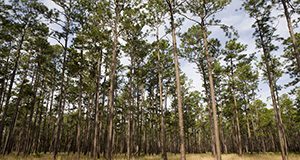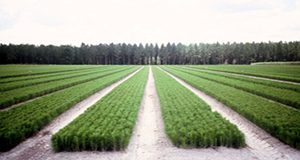This 6-page document is one in the Key Plant, Key Pests series. It helps identify the most common pests found on pine species. Written by Juanita Popenoe, Jacqueline Bourdon, Caroline R. Warwick, and Chris Marble and published by the UF/IFAS Environmental Horticulture Department, December 2018.
http://edis.ifas.ufl.edu/ep565
Tag: Pine
Genetically Improved Pines for Reforesting Florida's Timberlands
Just as farmers plant the best-available varieties of crops that have been developed through many generations of breeding, forest landowners should plant the best-available genetically improved varieties of pines for reforestation of their timberlands. This 8-page fact sheet written by Timothy L. White, Mary L. Duryea, and Gregory L. Powell and published by the UF/IFAS School of Forest Resources and Conservation explains how planting genetically improved varieties of pines can increase the productivity, health, and value of reforested Florida timberlands.
edis.ifas.ufl.edu/fr007
Common Pines of Florida
 Pine trees are highly important to Florida’s ecosystems and economy. There are seven species of native pines, and each grows best in a particular environment. People have found varied uses for each species as well. Several species are of commercial value and are cultivated and managed to provide useful products such as paper, industrial chemicals, and lumber. Some species are also managed to enhance wildlife habitat and to provide attractive landscapes. Of course, many pines grow naturally. Like any natural resource, pines may provide more benefits if they are managed wisely. This 11-page fact sheet written by Niels Proctor and Martha Monroe and published by the School of Forest Resources and Conservation gives an overview of the features and identification of the major pines found in Florida.
Pine trees are highly important to Florida’s ecosystems and economy. There are seven species of native pines, and each grows best in a particular environment. People have found varied uses for each species as well. Several species are of commercial value and are cultivated and managed to provide useful products such as paper, industrial chemicals, and lumber. Some species are also managed to enhance wildlife habitat and to provide attractive landscapes. Of course, many pines grow naturally. Like any natural resource, pines may provide more benefits if they are managed wisely. This 11-page fact sheet written by Niels Proctor and Martha Monroe and published by the School of Forest Resources and Conservation gives an overview of the features and identification of the major pines found in Florida.
http://edis.ifas.ufl.edu/fr003
Smooth-bark Mexican Pine (Pinus pseudostrobus)
 This beautiful pine is distinguished by long, pendulous needles that form a graceful, open evergreen conifer. The slender needles are up to 12 inches long in groups (fascicles) of five. In its native environment, smooth-bark Mexican pine is considered fast growing, and can reach more than 120 feet tall and about 60 feet wide. In southern Georgia, trees have reached heights of 32 feet and widths of 25 feet in 10 years. Trees have a pyramidal form when young, becoming flat-topped with age. In its native range, smooth-bark Mexican pine grows in temperate to warm temperate areas with predominately summer rainfall. Florida’s similar climatic conditions suggest that smooth-bark Mexican pine will adapt well throughout the state. Cold hardiness is not well-defined, but this species has grown well in southern Georgia (USDA Cold Hardiness Zone 8b). This 2-page fact sheet was written by Gary W. Knox, and published by the UF Department of Environmental Horticulture, June 2014.
This beautiful pine is distinguished by long, pendulous needles that form a graceful, open evergreen conifer. The slender needles are up to 12 inches long in groups (fascicles) of five. In its native environment, smooth-bark Mexican pine is considered fast growing, and can reach more than 120 feet tall and about 60 feet wide. In southern Georgia, trees have reached heights of 32 feet and widths of 25 feet in 10 years. Trees have a pyramidal form when young, becoming flat-topped with age. In its native range, smooth-bark Mexican pine grows in temperate to warm temperate areas with predominately summer rainfall. Florida’s similar climatic conditions suggest that smooth-bark Mexican pine will adapt well throughout the state. Cold hardiness is not well-defined, but this species has grown well in southern Georgia (USDA Cold Hardiness Zone 8b). This 2-page fact sheet was written by Gary W. Knox, and published by the UF Department of Environmental Horticulture, June 2014.
http://edis.ifas.ufl.edu/ep500
FOR236/FR298 Pitch Canker Disease of Pines
FOR236, a 4-page illustrated page fact sheet by Tyler Dreaden and Jason Smith, describes this disease of conifers caused by the fungus Fusarium circinatum — Symptoms and Signs, Disease Biology, Geographical Distribution and Management. Includes references. Published by the UF School of Forest Resources and Conservation, May 2010.
http://edis.ifas.ufl.edu/fr298

